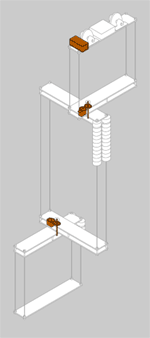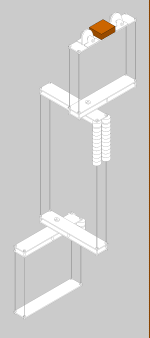overview
trundle
v1.2
anatomy
images
behavior
interaction
movement
trundle v1.1
+ anatomy
images
behavior
trundle v1.0
anatomy
images
|
 |
 |
Structure
The primary structural framework of Trundle is made from 3/16” aluminum
panels and 1/8” stainless steel rods. Steel counterweights are used
for balancing the asymmetric joints. Connections are made with shaft
collars. Each of the three sections are attached by a single .25”
steel rod, thus making the structure prone to oscillation and vibration.
When the sections are not connected with gears, the sculpture is
a smooth continuously moving mobile. Abec-5 bearings and the high
mass of the counterweights give the sculpture a high inertia which
keeps it in motion for a long duration, and as a direct result,
a great deal of force is required to stop it from turning. The bearings
attached to the wheels on top of the sculpture are not nearly as
loose, and the sculpture stops very quickly when pushed left or
right. |
 |
 |
Actuators
Trundle has three degrees of freedom. Its two cascading servo motors
each have a range of movement from 0 to 180 degrees giving it a
wide range of motion. A standard DC motor is mounted on the top
to provide lateral movement. |
 |
 |
Control
System
The core of Trundle’s control system is a 68HC11 microprocessor
which is situated in a Handyboard, an MIT designed controller board.
Trundle’s software for processing input and controlling motors
is written in the Interactive C programming language. |
 |
 |
Sensors
Trundle senses the world through an array of sensors which allows
it to recognize the proximity of nearby people and objects.
Sharp GP2D12 Infrared Ranger
+ continuous distance readings
+ reports the distance as an analog voltage
+ approximately 4”– 30” detection
Devantech SRF04 UltraSonic Ranger
+ measures a range from 3cm to 3m
+ cone of vision approximately 30 degrees
Eltec 442-3 Pyroelectric Detector
+ high gain detector with integral analog signal processing
+ attached Fresnel lens makes detecting left and right movement
possible
Custom Electric Field Sensor
+ large knit fabric integrated with conductive thread acts as electrode
+ op-amp based analog circuitry converts touch into changing voltage.
|
|

